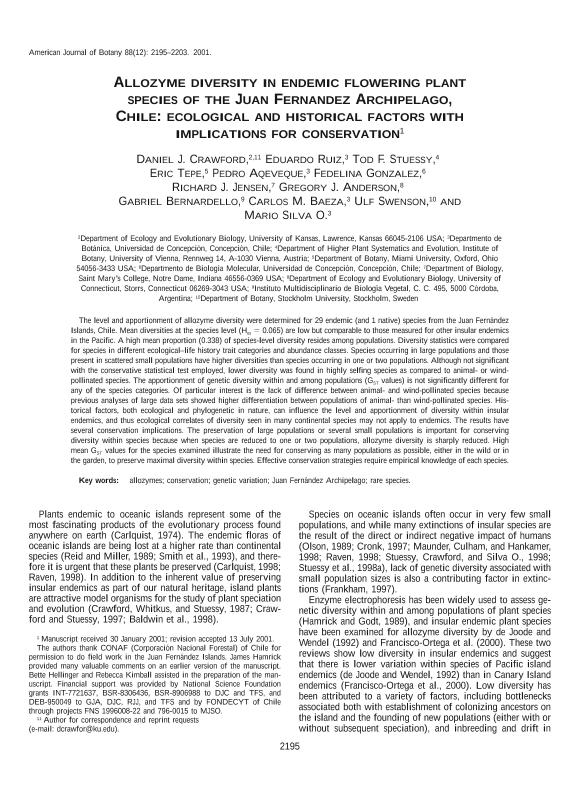Mostrar el registro sencillo del ítem
dc.contributor.author
Crawford, Daniel J.
dc.contributor.author
Ruiz, Eduardo
dc.contributor.author
Stuessy, Tod F.
dc.contributor.author
Tepe, Eric
dc.contributor.author
Aqeveque, Pedro
dc.contributor.author
Gonzalez, Fedelina
dc.contributor.author
Jensen, Richard J.
dc.contributor.author
Anderson, Gregory J.
dc.contributor.author
Bernardello, Gabriel Luis Mario

dc.contributor.author
Baeza, Carlos M.
dc.contributor.author
Swenson, Ulf
dc.contributor.author
Silva, Mario O.
dc.date.available
2018-03-13T16:56:07Z
dc.date.issued
2001-12
dc.identifier.citation
Crawford, Daniel J.; Ruiz, Eduardo; Stuessy, Tod F.; Tepe, Eric; Aqeveque, Pedro; et al.; Allozyme diversity in endemic flowering plant species of the Juan Fernandez Archipelago, Chile: Ecological and historical factors with implications for conservation; Botanical Society of America; American Journal of Botany; 88; 12; 12-2001
dc.identifier.issn
0002-9122
dc.identifier.uri
http://hdl.handle.net/11336/38668
dc.description.abstract
The level and apportionment of allozyme diversity were determined for 29 endemic (and 1 native) species from the Juan Fernández Islands, Chile. Mean diversities at the species level (Hes = 0.065) are low but comparable to those measured for other insular endemics in the Pacific. A high mean proportion (0.338) of species-level diversity resides among populations. Diversity statistics were compared for species in different ecological–life history trait categories and abundance classes. Species occurring in large populations and those present in scattered small populations have higher diversities than species occurring in one or two populations. Although not significant with the conservative statistical test employed, lower diversity was found in highly selfing species as compared to animal- or wind-pollinated species. The apportionment of genetic diversity within and among populations (GST values) is not significantly different for any of the species categories. Of particular interest is the lack of difference between animal- and wind-pollinated species because previous analyses of large data sets showed higher differentiation between populations of animal- than wind-pollinated species. Historical factors, both ecological and phylogenetic in nature, can influence the level and apportionment of diversity within insular endemics, and thus ecological correlates of diversity seen in many continental species may not apply to endemics. The results have several conservation implications. The preservation of large populations or several small populations is important for conserving diversity within species because when species are reduced to one or two populations, allozyme diversity is sharply reduced. High mean GST values for the species examined illustrate the need for conserving as many populations as possible, either in the wild or in the garden, to preserve maximal diversity within species. Effective conservation strategies require empirical knowledge of each species.
dc.format
application/pdf
dc.language.iso
eng
dc.publisher
Botanical Society of America

dc.rights
info:eu-repo/semantics/openAccess
dc.rights.uri
https://creativecommons.org/licenses/by-nc-sa/2.5/ar/
dc.subject
Juan Fernandez Archipielago
dc.subject
Genetic Variation
dc.subject
Allozymes
dc.subject.classification
Otras Ciencias Biológicas

dc.subject.classification
Ciencias Biológicas

dc.subject.classification
CIENCIAS NATURALES Y EXACTAS

dc.title
Allozyme diversity in endemic flowering plant species of the Juan Fernandez Archipelago, Chile: Ecological and historical factors with implications for conservation
dc.type
info:eu-repo/semantics/article
dc.type
info:ar-repo/semantics/artículo
dc.type
info:eu-repo/semantics/publishedVersion
dc.date.updated
2018-03-07T16:05:24Z
dc.identifier.eissn
1537-2197
dc.journal.volume
88
dc.journal.number
12
dc.journal.pais
Estados Unidos

dc.journal.ciudad
St. Louis
dc.description.fil
Fil: Crawford, Daniel J.. Kansas State University; Estados Unidos
dc.description.fil
Fil: Ruiz, Eduardo. Universidad de Concepción; Chile
dc.description.fil
Fil: Stuessy, Tod F.. Universidad de Viena; Austria
dc.description.fil
Fil: Tepe, Eric. Miami University; Estados Unidos
dc.description.fil
Fil: Aqeveque, Pedro. Universidad de Concepción; Chile
dc.description.fil
Fil: Gonzalez, Fedelina. Universidad de Concepción; Chile
dc.description.fil
Fil: Jensen, Richard J.. Saint Mary's College; Estados Unidos
dc.description.fil
Fil: Anderson, Gregory J.. University of Connecticut; Estados Unidos
dc.description.fil
Fil: Bernardello, Gabriel Luis Mario. Consejo Nacional de Investigaciones Científicas y Técnicas. Centro Científico Tecnológico Conicet - Córdoba. Instituto Multidisciplinario de Biología Vegetal. Universidad Nacional de Córdoba. Facultad de Ciencias Exactas Físicas y Naturales. Instituto Multidisciplinario de Biología Vegetal; Argentina
dc.description.fil
Fil: Baeza, Carlos M.. Universidad de Concepción; Chile
dc.description.fil
Fil: Swenson, Ulf. Stockholms Universitet; Suecia
dc.description.fil
Fil: Silva, Mario O.. Universidad de Concepción; Chile
dc.journal.title
American Journal of Botany

dc.relation.alternativeid
info:eu-repo/semantics/altIdentifier/url/http://onlinelibrary.wiley.com/doi/10.2307/3558381/abstract
dc.relation.alternativeid
info:eu-repo/semantics/altIdentifier/doi/http://dx.doi.org/10.2307/3558381
Archivos asociados
